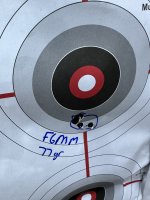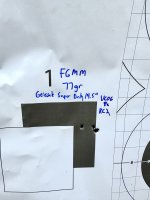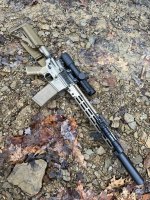14.5 1/7 twist, just looking for what the most accurate round would be to go with. I shoot target 55 and 62 but I'm curious if there is a gold standard round for that setup.
- Thread starter lyncassady
- Start date
You are using an out of date browser. It may not display this or other websites correctly.
You should upgrade or use an alternative browser.
You should upgrade or use an alternative browser.
14.5 1/7 twist, just looking for what the most accurate round would be to go with. I shoot target 55 and 62 but I'm curious if there is a gold standard round for that setup.
Black hills 77gr Match
Federal Gold medal Match 77grn
I have shoot BH 77gr works great
Some of the Hornady match ammo is to hot for my AR pierced primers in both my Sig and Rugger
Some of the Hornady match ammo is to hot for my AR pierced primers in both my Sig and Rugger
I found BH 69gr SMK shot more precisely out of my precision AR than 77gr. Just have to consider different external ballistics between the two.
14.5 1/7 twist, just looking for what the most accurate round would be to go with. I shoot target 55 and 62 but I'm curious if there is a gold standard round for that setup.
Federal 69 grain Gold Medal Match Ammunition Accuracy
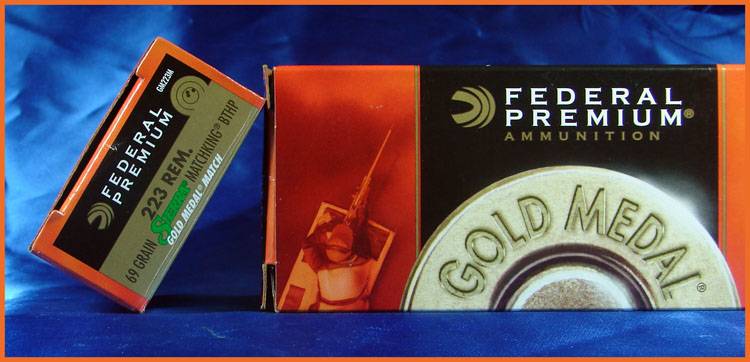
In their 1984 catalog, Sierra Bullets introduced the .22 caliber (0.224”) 69 grain MatchKing HPBT (hollow point boat tail) bullet (#1380). The 69 grain MatchKing was “developed as a target bullet for testing by military teams in the new M16A2 rifle”* and the bullet became a popular choice for shooters using the AR-15 in High Power Rifle Competition.
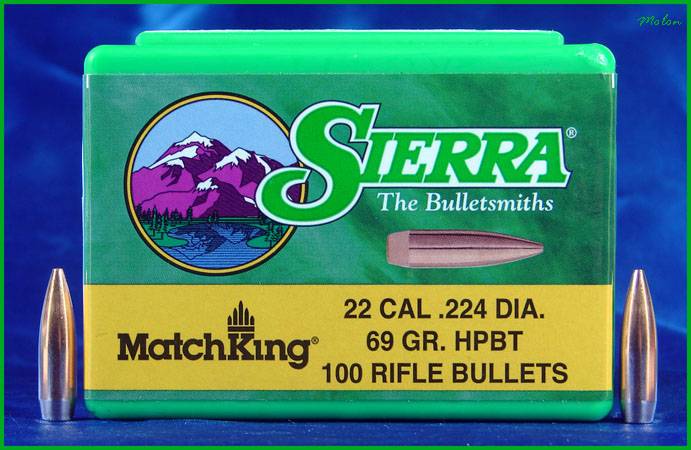
While the US military had experimented with “heavy” FMJ (full metal jacket) bullets for the 5.56mm cartridge as far back as the mid-1960s, (the Colt/Federal 5.56mm 68 grain FMJ) the .22 caliber 69 grain MatchKing was the first heavy OTM (open-tip match) bullet that was available to the general public as a reloading component for 223 Remington/5.56mm cartridges. (Hornady’s 68 grain OTM bullet (#2278) wasn’t introduced until approximately two years later.)

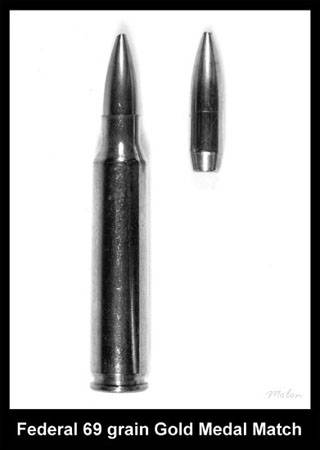
In their 1989 ammunition catalog, the Federal Cartridge Company debuted an addition to its “Match” line-up of factory loaded rifle ammunition; a 223 Remington load topped with none other than the Sierra 69 grain MatchKing (223M). In their 1992 catalog, Federal expanded the nomenclature for this load to “Premium Match” (P223M) and in their 1993 catalog it became “Gold Medal Match” (GM223M) as part of a marketing campaign capitalizing on the USA Shooting Team’s success in the Barcelona Olympics using Federal ammunition.
It’s interesting to note that pertaining to the accuracy/precision development and multifaceted testing of the Federal ammunition that helped the US Olympians win gold and silver medals in Barcelona, Federal’s Director of Product Engineering, Dave Longren, had this to say:
“The standard test string was three 10-shot groups, with the most attention paid to the 30-shot composite. When you’re working at this level, the traditional five 5-shot group test simply doesn’t give you statistically valid results.”**
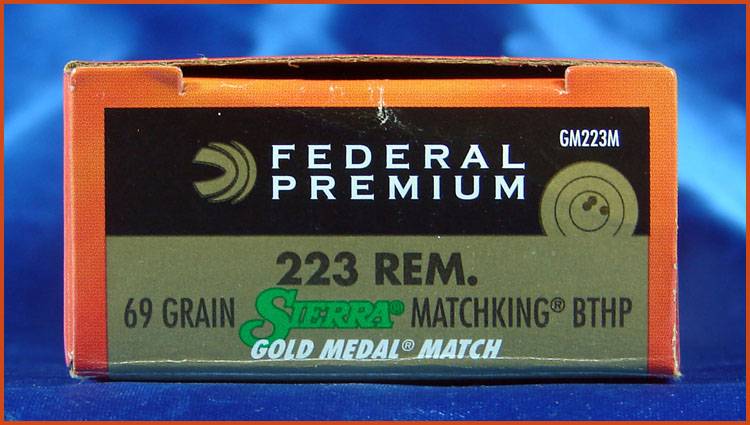

The 69 grain Sierra MatchKings loaded in the lot of Federal Gold Medal Match ammunition that I evaluated for this article had a nominal length of 0.890”. The nominal cartridge OAL of this load was 2.248”. Through some simple testing, I determined that the 69 grain MatchKing has a specific gravity of approximately 10.2.
According to Ballistic Performance of Rifle Bullets by Bryan Litz, the 69 grain MatchKing has an average G1 ballistic coefficient of 0.330 and an average G7 ballistic coefficient of 0.169. The same source states that the “recommended twist for optimal performance” of the 69 grain MatchKing “is 1:9.5” or faster.”
The 69 grain MatchKings that top the Federal Gold Medal Match ammunition are loaded in Federal brass. The head stamp for this lot reads “FC 13 223 REM”. The rounds are primed with Federal Gold Medal Small Rifle Match Primers (GM205M). The primer pockets are crimped and sealed with a blue lacquer sealant.
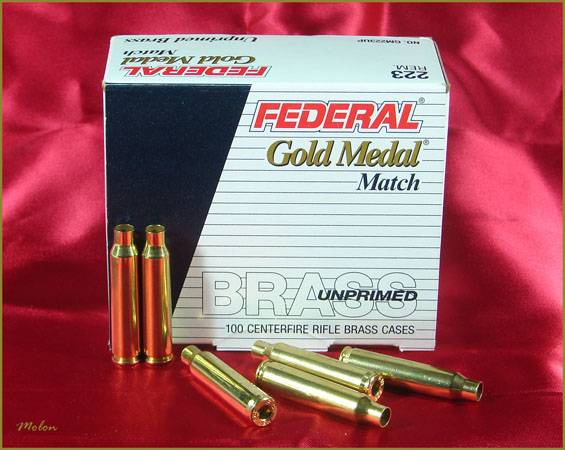
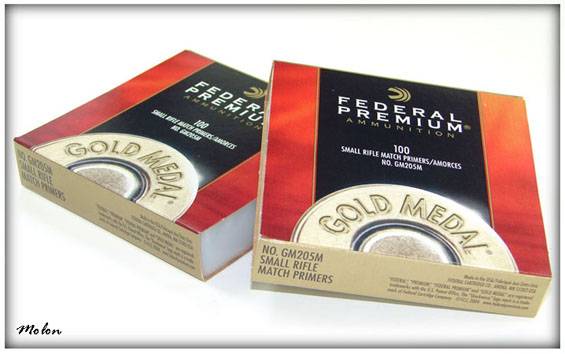

The case-mouths of this lot of Federal 69 grain Gold Medal Match ammunition are sealed with asphalt sealant. The case-mouths have a slight taper-crimp which produces a shallow circumferential crease in the bearing surface of the 69 grain MatchKings. The pic below shows a pulled bullet on the right (the crease in the bullet indicated by the red arrow) next to a virgin 69 grain MatchKing on the left.

This lot of ammunition is charged with a “ball powder” (though I have seen lots in the past that were charged with a short-cut extruded powder.) The squares in the red grid pictured below are 1/10th of an inch.
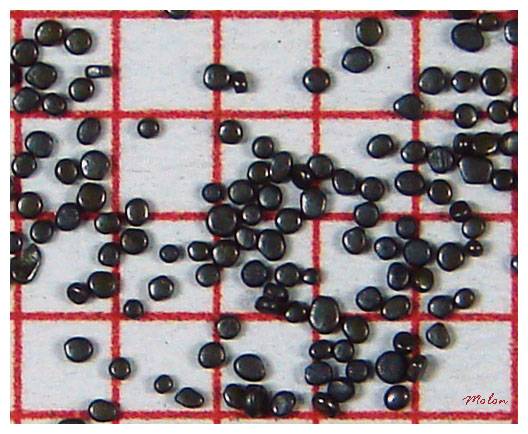
Velocity
When it was first introduced, Federal advertised the muzzle velocity of the 69 grain Gold Medal Match ammunition as 3000 FPS. More recent advertising lists the muzzle velocity at 2950 FPS. These figures are from 24” barrels.


I chronographed the Federal 69 grain Gold Medal Match ammunition from a semi-automatic AR-15 with a chrome-lined, NATO chambered 20” Colt M16A2 barrel with a 1:7” twist.

Chronographing was conducted using an Oehler 35-P chronograph with “proof screen” technology. The Oehler 35P chronograph is actually two chronographs in one package that takes two separate chronograph readings for each shot and then utilizes its onboard computer to analyze the data to determine if there is any statistically significant difference between the two readings. If there is a statistically significant difference in the readings, the chronograph “flags” the shot to let you know that the data is invalid. There was no invalid data flagged during this testing.
The velocities stated below are the muzzle velocities as calculated from the instrumental velocities using Oehler’s Ballistic Explorer software program. The strings of fire consisted of 10 rounds over the chronograph.
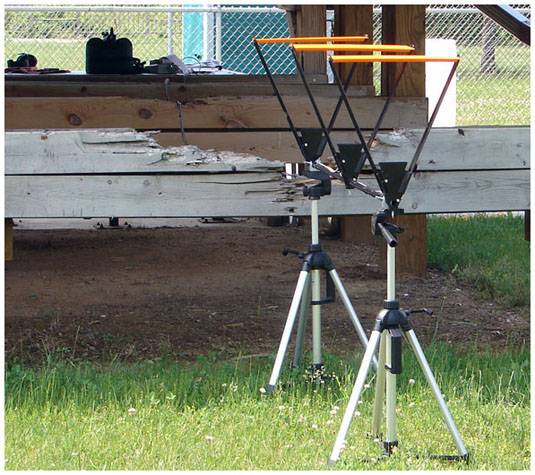
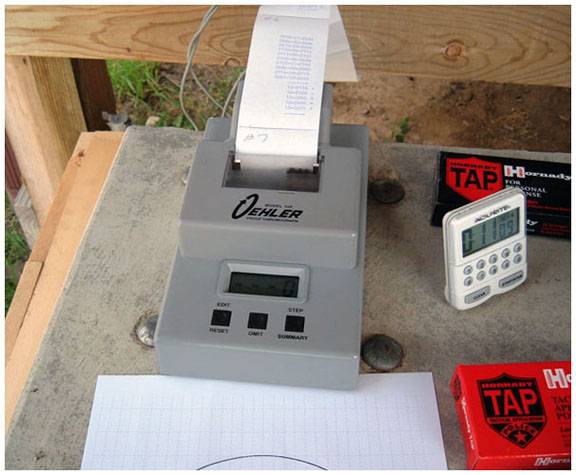
Each round was single-loaded and cycled into the chamber from a magazine fitted with a single-load follower. The bolt locked-back after each shot allowing the chamber to cool in between each shot. This technique was used to mitigate the possible influence of “chamber-soak” on velocity data. Each new shot was fired in a consistent manner after hitting the bolt release. Atmospheric conditions were monitored and recorded using a Kestrel 4000 Pocket Weather Tracker.
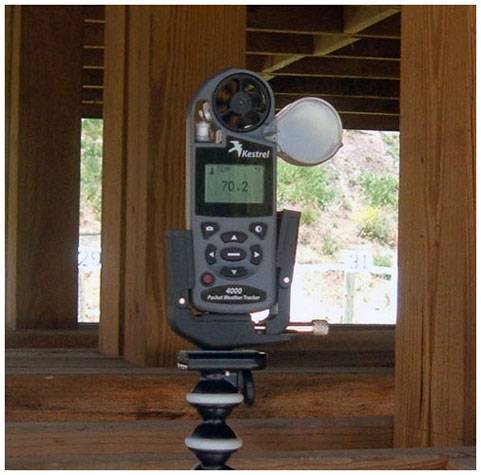
Atmospheric conditions
Temperature: 70 degrees F
Humidity: 76%
Barometric pressure: 30.14 inches of Hg
Elevation: 950 feet above sea level
The muzzle velocity for the 10-shot string of the Federal 69 grain Gold Medal Match ammunition fired from the 20” Colt barrel was 2732 FPS with a standard deviation of 16 FPS and a coefficient of variation of 0.59%.
For those of you who might not be familiar with the coefficient of variation (CV), it is the standard deviation, divided by the mean (average) muzzle velocity and then multiplied by 100 and expressed as a percentage. It allows for the comparison of the uniformity of velocity between loads in different velocity spectrums; e.g. 77 grain loads running around 2,650 fps compared to 55 grain loads running around 3,250 fps.
For comparison, the mil-spec for M193 allows for a coefficient of variation of approximately 1.2%, while one of my best 77 grain OTM hand-loads, with a muzzle velocity of 2639 PFS and a standard deviation of 4 FPS, has a coefficient of variation of 0.15%.

Over the last decade I’ve chronographed several other lots of the Federal 69 grain Gold Medal Match ammunition from a variety of barrels. The muzzle velocities of those lots are shown in the table below.

Accuracy
I conducted an accuracy (technically, precision) evaluation of the Federal 69 grain Gold Medal Match ammunition following my usual protocol. This accuracy evaluation used statistically significant shot-group sizes and every single shot in a fired group was included in the measurements. There was absolutely no use of any group-reduction techniques (e.g. fliers, target movement, Butterfly Shots).
The shooting set-up will be described in detail below. As many of the significant variables as was practicable were controlled for. Also, a control group was fired from the test-rifle used in the evaluation using match-grade, hand-loaded ammunition; in order to demonstrate the capability of the barrel. Pictures of shot-groups are posted for documentation.
All shooting was conducted from a concrete bench-rest from a distance of 100 yards (confirmed with a laser rangefinder.) The barrel used in the evaluation was free-floated. The free-float handguards of the rifle rested in a Sinclair Windage Benchrest, while the stock of the rifle rested in a Protektor bunny-ear rear bag. Sighting was accomplished via a Leupold Competition Series 45x45mm scope adjusted to be parallax-free at 100 yards. A mirage shield was attached to the top of the free-float handguard. Wind conditions on the shooting range were continuously monitored using a Wind Probe. The set-up was very similar to that pictured below.
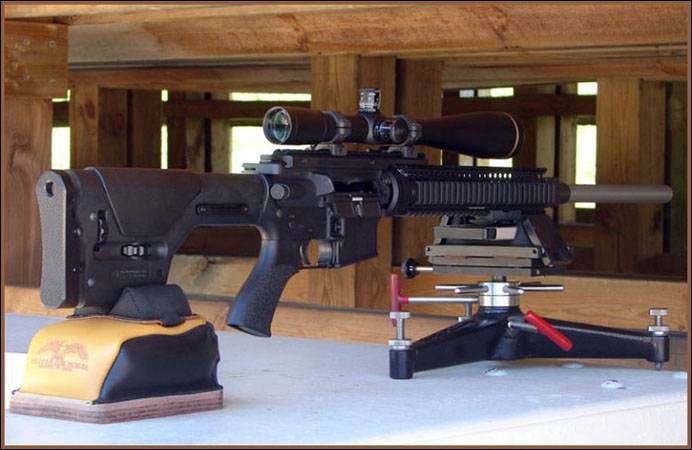
The Wind Probe.

The test vehicle for this accuracy evaluation was one of my semi-automatic precision AR-15s with a 24” Krieger barrel. The barrel has a 5.56mm Match chamber with a 1:7.7” twist. Prior to firing the 69 grain Gold Medal Match ammunition, I fired a 10-shot control group using match-grade hand-loads topped with the Barnes 85 grain Match Burner. That group had an extreme spread of 0.56”.
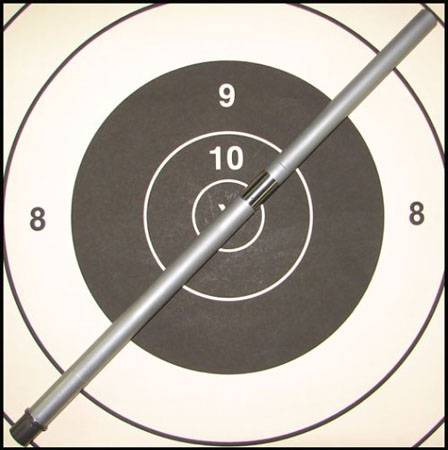
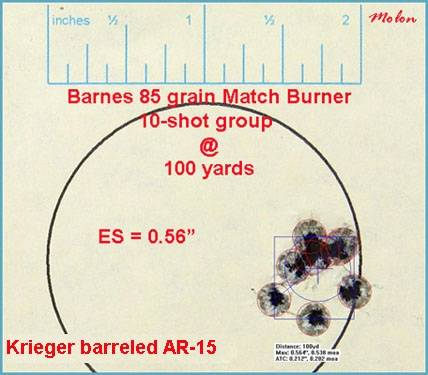
Three 10-shot groups of the 69 grain Gold Medal Match ammunition were fired in a row with the resulting extreme spreads:
0.67”
0.73”
0.67”
for a 10-shot group average extreme spread of 0.69”. The three 10-shot groups were over-layed on each other using RSI Shooting Lab to form a 30-shot composite group. The mean radius for the 30-shot composite group was 0.24”.
The smallest 10-shot group . . .
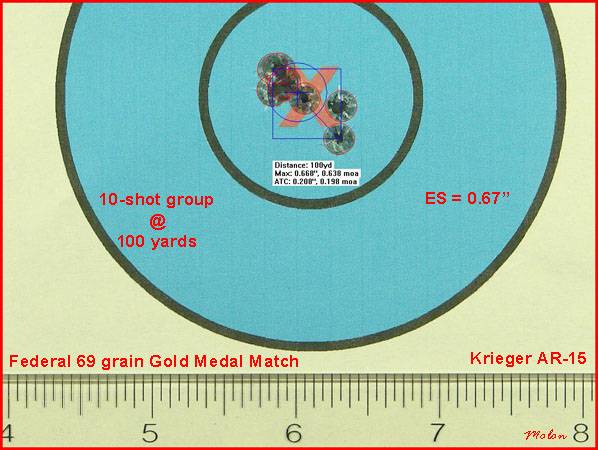
The 30-shot composite group . . .

....
* Technical Staff. “Sierra .22 Cal. 69-gr. MatchKing.” American Rifleman Jan. 1984: 60-61. Print.
** Hunnicutt, Robert. “Ammo Good as Gold.” American Rifleman Nov. 1992: 32-33, 72-73. Print.
....
I shot a lot of black hills 77OTM, 77TMK’S and 69 TMK’S and it was unrivaled in velocity and accurac. It cost a small fortune if you can find it but it rein’s supreme in my book.
granted, I have not shot a great deal of factory 556 ammo, mostly handloads but it was not reproducable in trying to build same results. FGGM is great and much more easily accessible. And more reasonable priced.
PB
granted, I have not shot a great deal of factory 556 ammo, mostly handloads but it was not reproducable in trying to build same results. FGGM is great and much more easily accessible. And more reasonable priced.
PB
Agree on all mentioned, will add HSM 55 Blitz Kings and Fiocchi Exacta 77 SMK.
That's good to hear cause I bought some as well when it was on sale, haven't shot it yet thoughI recently started shooting some Norma Golden Target 69gr, seems to perform about as well as FGMM in my AR
Black Hills 77gr SMK is the only ammo that has been consistently good for me. It's also the standard for shooting 223 long range semi auto
Tell us more about the barrel14.5 1/7 twist, just looking for what the most accurate round would be to go with. I shoot target 55 and 62 but I'm curious if there is a gold standard round for that setup.
IMI Razorcore with the 77g SMK is pretty good
PMC X-tac match with the 77g SMK works well too
Didn't care for Gorilla match with the 77g SMK, it's inconsistant.
PPU match was terrible for me
Fiocchi match in 69 and 77 works well
That's about all I have that hasn't been mentioned yet.
Probably some I missed, kinda hard to remember all the 223/556 that I've run over the years.
PMC X-tac match with the 77g SMK works well too
Didn't care for Gorilla match with the 77g SMK, it's inconsistant.
PPU match was terrible for me
Fiocchi match in 69 and 77 works well
That's about all I have that hasn't been mentioned yet.
Probably some I missed, kinda hard to remember all the 223/556 that I've run over the years.
Having taught open enrollment Precision Rifle for the better part of a decade with a particular focus on .223/5.56 carbines/rifles and dabbling in gas-centric comps, I can say without a doubt Federal Gold Medal Match is hands down the winner. I prefer 77gr. loads, on calm days you can push them insanely far and the fact usually is that most shooters can’t out shoot it. Velocity from lot to lot has been amazingly consistent.
Norma 77gr. Has been something I’ve been seeing a lot more of lately and would be my second choice.
Everything else is subject to a case by case basis. Some of the other factory ammunition seems to see a little more variation from lot to lot, you might get a great loading then the next lot might be so, so. But I can pretty much travel anywhere in the nation grab a box of FGMM off the shelf and know that it’s going to preform well within my requirements for accuracy and precision.
Only downside is it’s going to cost you, no free lunch.
As a snapshot, below is what my 2 personal 5.56 carbines are doing. One is a Hodge Defense 14.5” and a 16” Craddock cut Bart, both 1/7s. Both rifles are equipped with LPVOs, so maybe there’s a smidge more of accuracy to be squeezed out.


Norma 77gr. Has been something I’ve been seeing a lot more of lately and would be my second choice.
Everything else is subject to a case by case basis. Some of the other factory ammunition seems to see a little more variation from lot to lot, you might get a great loading then the next lot might be so, so. But I can pretty much travel anywhere in the nation grab a box of FGMM off the shelf and know that it’s going to preform well within my requirements for accuracy and precision.
Only downside is it’s going to cost you, no free lunch.
As a snapshot, below is what my 2 personal 5.56 carbines are doing. One is a Hodge Defense 14.5” and a 16” Craddock cut Bart, both 1/7s. Both rifles are equipped with LPVOs, so maybe there’s a smidge more of accuracy to be squeezed out.
Last edited:
No love for mk262?Having taught open enrollment Precision Rifle for the better part of a decade with a particular focus on .223/5.56 carbines/rifles and dabbling in gas-centric comps, I can say without a doubt Federal Gold Medal Match is hands down the winner. I prefer 77gr. loads, on calm days you can push them insanely far and the fact usually is that most shooters can’t out shoot it. Velocity from lot to lot has been amazingly consistent.
Norma 77gr. Has been something I’ve been seeing a lot more of lately and would be my second choice.
Everything else is subject to a case by case basis. Some of the other factory ammunition seems to see a little more variation from lot to lot, you might get a great loading then the next lot might be so, so. But I can pretty much travel anywhere in the nation grab a box of FGMM off the shelf and know that it’s going to preform well within my requirements for accuracy and precision.
Only downside is it’s going to cost you, no free lunch.
As a snapshot, below is what my 2 personal 5.56 carbines are doing. One is a Hodge Defense 14.5” and a 16” Craddock cut Bart, both 1/7s. Both rifles are equipped with LPVOs, so maybe there’s a smidge more of accuracy to be squeezed out.
View attachment 8059014
View attachment 8059015
I found a small company loading 77tmk hot and accurate , but coming from you Il try some FGMM
Mk262 was pretty good in it’s hay day but I’ve found it to be a little inconsistent in accuracy lot to lot compared to FGMM these days. Mostly it’s good stuff 0.8-1.2ish but also harder and harder to find too.No love for mk262?
I found a small company loading 77tmk hot and accurate , but coming from you Il try some FGMM
New member here... just wondering if anyone has tried the hornady frontier .223, #fr160 68 grain bthp match load
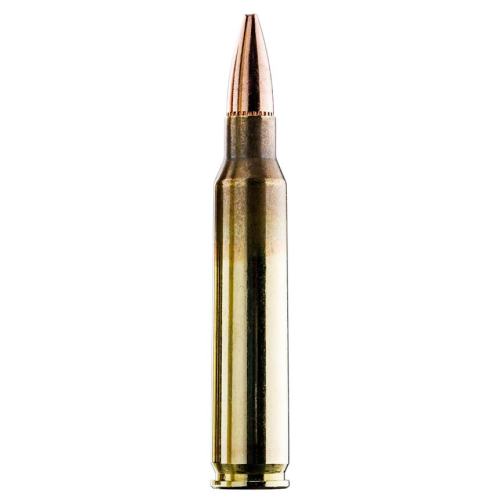
Black Hills Ammo MK 262 MOD 1-C 5.56 77 Gr MK 460 Ct
Black Hills MK 262 MOD 1-C, MIL PACK 460 ct Back in 1999, at the request of the U.S. Navy Black Hills began the process of developing the 5.56mm military precision round. Eventually, after extensive development and even more extensive field testing, that idea became the only one of its...
www.creedmoorsports.com
just put in stock
No love for mk262?
You'll be hard pressed to find 5.56 MK262 Mod 1 shooting more precisely from a semi-automatic AR-15 than 223 Remington Federal Gold Medal Match.
Black Hills MK262 Mod1 Ammunition

The 77 grain MK262 ammunition produced by Black Hills Ammunition has been referred to as the most accurate mass-produced 5.56mm ammunition that has ever been type-classified and issued by the US military. Since its inception, genuine MK262 has been manufactured solely by Black Hills Ammunition. For years, MK262 was only available to the civilian population as “seconds,” but more recently Black Hills has made first-run production lots available on the commercial market. It is the first-run version of MK262 Mod 1 that I tested for this report.
MK262 Mod 1 is loaded in WCC 5.56mm brass and uses a cannelured version of the 77 grain Sierra MatchKing. The round is charged with a proprietary ball powder. The primer pockets are crimped and sealed. Contrary to erroneous information that has been posted on the Internet, MK262 Mod 1 does not have case-mouth sealant.

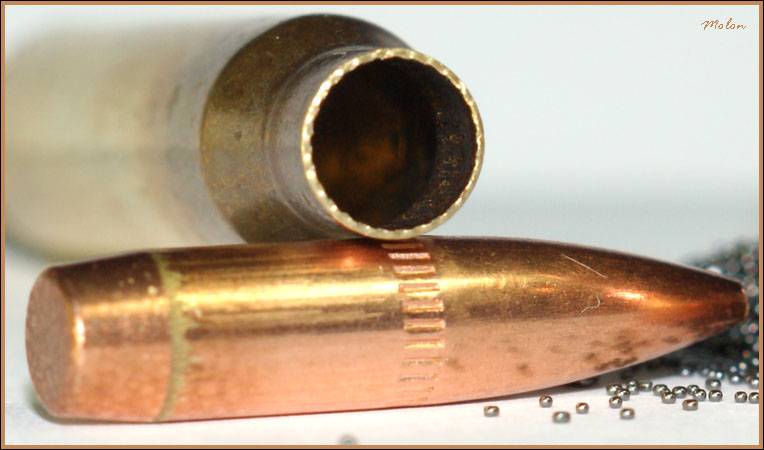
The 77 grain MK262 Mod 1 projectile compared to the M193 projectile.

MK262 powder. (The squares of the red grid measure 1/10 of an inch.)
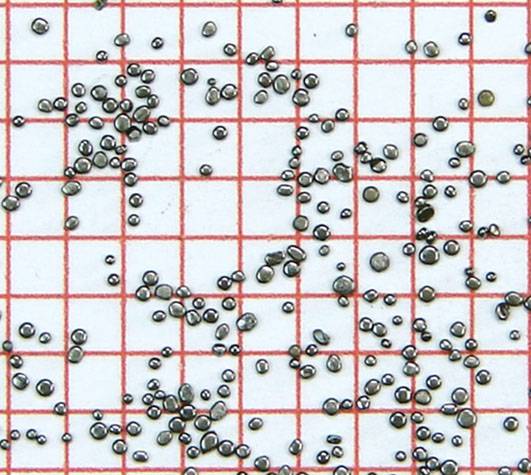
Velocity
I chronographed the Black Hills 5.56mm MK262 Mod 1 ammunition from a semi-automatic AR-15 with a chrome-lined, NATO chambered 20” Colt M16A2 barrel.

Chronographing was conducted using an Oehler 35-P chronograph with “proof screen” technology. The Oehler 35P chronograph is actually two chronographs in one package that takes two separate chronograph readings for each shot and then has its onboard computer analyze the data to determine if there is any statistically significant difference between the two readings. If there is, the chronograph “flags” the shot to let you know that the data is invalid. There was no invalid data flagged during this testing.
The velocity stated below is the muzzle velocity as calculated from the instrumental velocity using Oehler’s Ballistic Explorer software program. The string of fire consisted of 10 rounds over the chronograph.
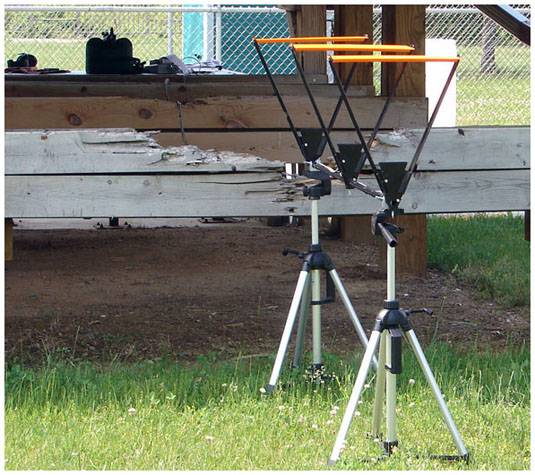

Each round was single-loaded and cycled into the chamber from a magazine fitted with a single-load follower. The bolt locked-back after each shot allowing the chamber to cool in between each shot. This technique was used to mitigate the possible influence of “chamber-soak” on velocity data. Each new shot was fired in a consistent manner after hitting the bolt release. Atmospheric conditions were monitored and recorded using a Kestrel 4000 Pocket Weather Tracker.

Atmospheric conditions
Temperature: 79 degrees F
Humidity: 37%
Barometric pressure: 30.12 inches of Hg
Elevation: 950 feet above sea level
The muzzle velocity for the 10-shot string of the Black Hills 5.56mm MK262 Mod 1 ammunition fired from the 20” Colt barrel was 2848 FPS with a standard deviation of 10 FPS and a coefficient of variation of 0.35%
For those of you who might not be familiar with the coefficient of variation (CV), it is the standard deviation, divided by the mean (average) muzzle velocity and then multiplied by 100 and expressed as a percentage. It allows for the comparison of the uniformity of velocity between loads in different velocity spectrums; e.g. 77 grain loads running around 2,650 fps compared to 55 grain loads running around 3,250 fps.
For comparison (and to give you an idea of how good the CV is for this factory loaded MK262 Mod 1 ammunition) the mil-spec for M193 allows for a coefficient of variation of approximately 1.2%, while one of my best 77 grain OTM hand-loads, with a muzzle velocity of 2639 PFS and a standard deviation of 4 FPS, has a coefficient of variation of 0.15%.

Accuracy
The specification for the accuracy/precision portion of the lot-acceptance-testing of MK262 calls for multiple 10shot groups to be fired from machine-rested, heavy test barrels. I conducted an accuracy (technically, precision) evaluation of the first-run MK262 Mod 1 ammunition following my usual protocol. This accuracy evaluation used statistically significant shot-group sizes and every single shot in a fired group was included in the measurements. There was absolutely no use of any Group Reduction Techniques (e.g. fliers, target movement, Butterfly Shots).
The shooting set-up will be described in detail below. As many of the significant variables as was practicable were controlled for. Also, a control group was fired from the test-rifle used in the evaluation using match-grade, hand-loaded ammunition; in order to demonstrate the capability of the barrel. Pictures of shot-groups are posted for documentation.
All shooting was conducted from a concrete bench-rest from a distance of 100 yards (confirmed with a laser rangefinder.) The barrel used in the evaluation was free-floated. The free-float handguards of the rifle rested in a Sinclair Windage Benchrest, while the stock of the rifle rested in a Protektor bunny-ear rear bag. Sighting was accomplished via a Leupold VARI-X III set at 25X magnification and adjusted to be parallax-free at 100 yards. A mirage shade was attached to the top of the free-float hand-guard. Wind conditions on the shooting range were continuously monitored using a Wind Probe. The set-up was very similar to that pictured below.
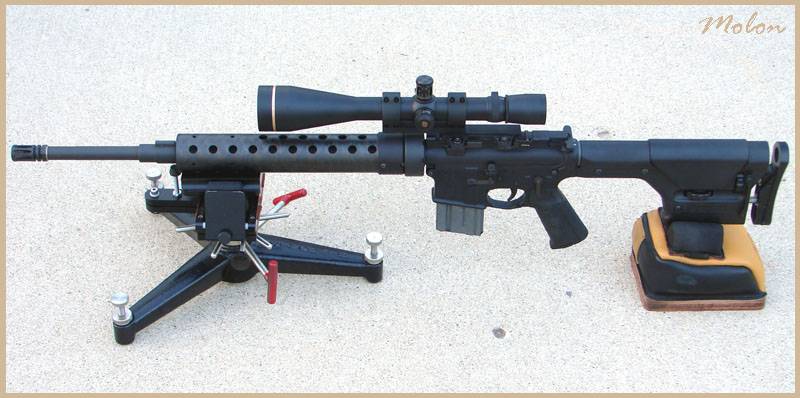
The Wind Probe.
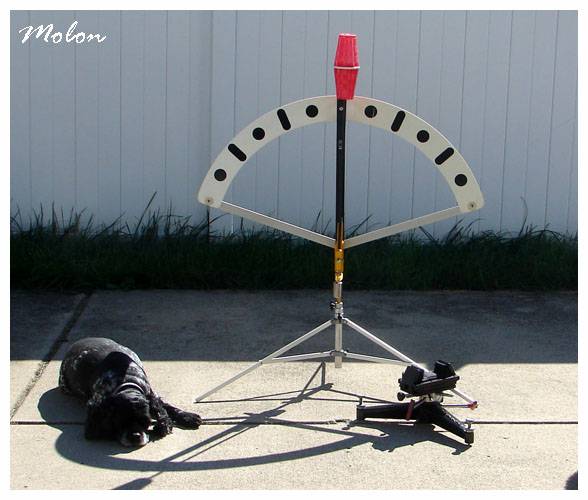
The test vehicle for this evaluation was one of my semi-automatic precision AR-15s with a 20” stainless-steel Lothar Walther barrel. The barrel has a 223 Wylde chamber with a 1:8” twist.
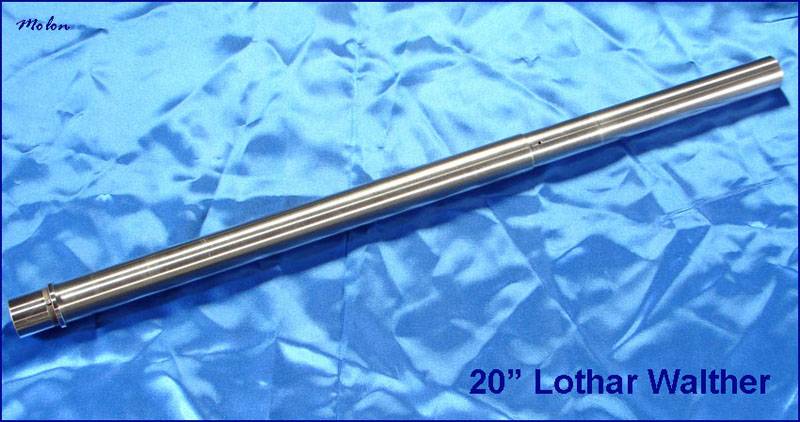
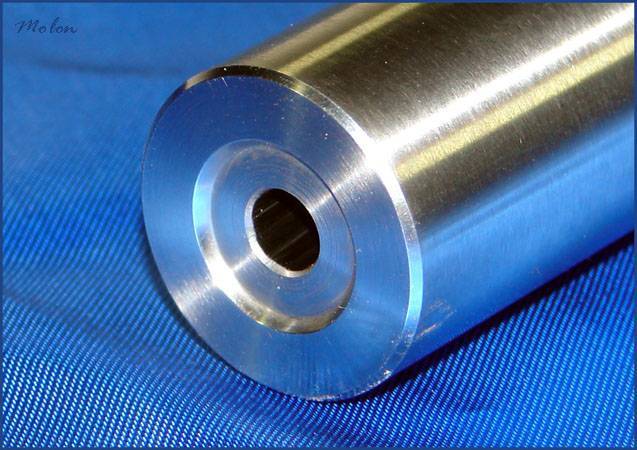
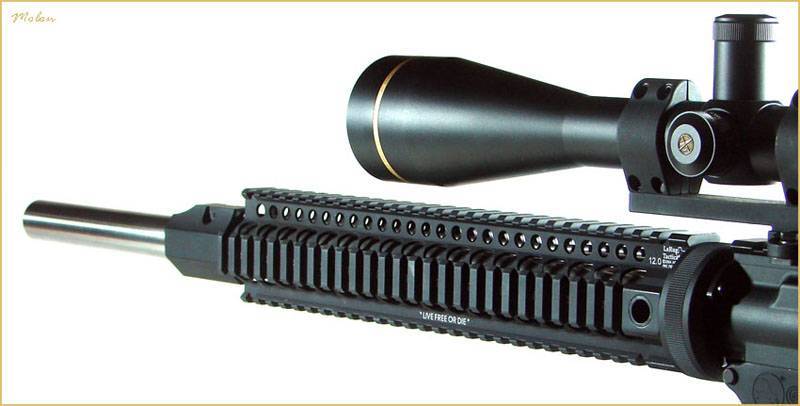
Prior to firing the MK262 ammunition, I fired a 10-shot control group using match-grade hand-loads topped with the Sierra 77 grain MatchKing. That group had an extreme spread of 0.69”.
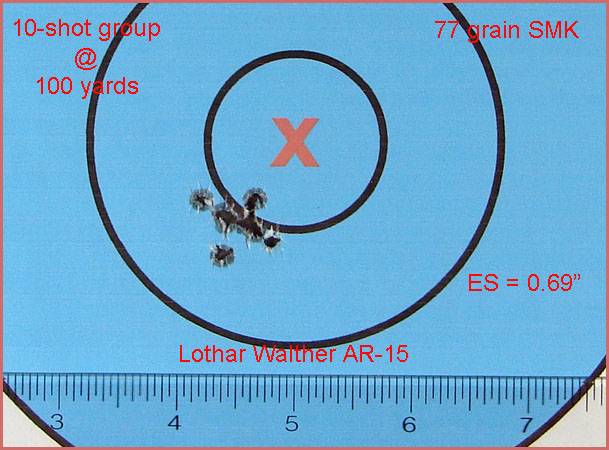
Three 10-shot groups of the MK262 Mod 1 were fired in a row with the resulting extreme spreads (from smallest to largest):
0.96”
1.12”
1.21”
for a 10-shot group average extreme spread of 1.10”. The three 10-shot groups were over-layed on each other using RSI Shooting Lab to form a 30-shot composite group. The mean radius for the 30-shot composite group was 0.33”.
The smallest 10-shot group.
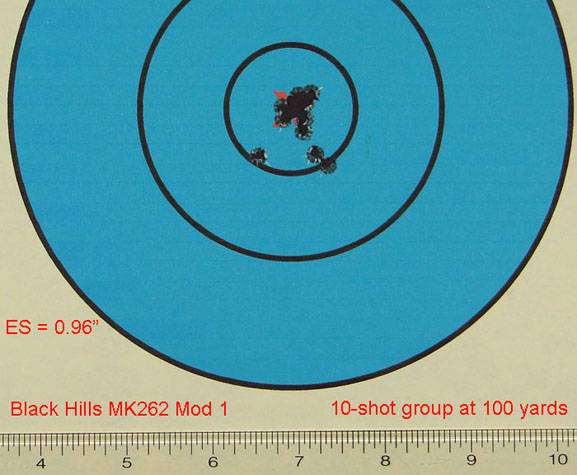
The 30-shot composite group.
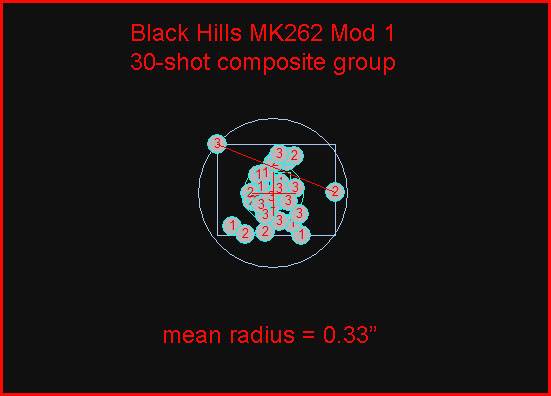

….
Black Hills 5.56mm MK262 Mod 1 Ammo MOD 1 - C 77 Gr OTM - Ammo Deals
Black Hills 5.56mm MK262 Mod 1 Ammo MOD 1 - C 77 Grain OTM ammo for sale at Target Sports USA. Enjoy free shipping on bulk 5.56mm NATO ammunition for
I don't have a 14.5" so I can't comment about that.
I do have 16", 18" and 20" barrels. The 16" and 20" are 1-7 twist with 5.56 chamber while the 18" is 1-8 with a 223 Wylde chamber. Out of the match grade ammo I have tried in all three rifles, the Federal Gold Match 69Gr has shot the best. The Hornady Match 75Gr was a close second.
The best thing to do is try different ammo to see what your rifle likes best. That being said, Federal Gold Match 69Gr is a good starting point.
I do have 16", 18" and 20" barrels. The 16" and 20" are 1-7 twist with 5.56 chamber while the 18" is 1-8 with a 223 Wylde chamber. Out of the match grade ammo I have tried in all three rifles, the Federal Gold Match 69Gr has shot the best. The Hornady Match 75Gr was a close second.
The best thing to do is try different ammo to see what your rifle likes best. That being said, Federal Gold Match 69Gr is a good starting point.
FGMM 77gr .223 SMK FGMM....F C 223 REM..........................
Av. 2340 , ES 25................
Av. 2411 , ES 33.............. Very good accuracy
Black Hills 77gr 5.56 OTM .........LC 14 ( NATO Cross )............
Av. 2592 , ES 21................
Av. 2675 , ES 82..............Very accurate
Black Hills 77gr 5.56 TMK .........WCC 14 ( NATO Cross )...........
Av. 2636 , ES 54................
Av. 2753 , ES 63..............Outstanding Accuracy.
If these velocity’s are accurate re 262 v fgmm,
I’d say that’s a BIG difference
Av. 2340 , ES 25................
Av. 2411 , ES 33.............. Very good accuracy
Black Hills 77gr 5.56 OTM .........LC 14 ( NATO Cross )............
Av. 2592 , ES 21................
Av. 2675 , ES 82..............Very accurate
Black Hills 77gr 5.56 TMK .........WCC 14 ( NATO Cross )...........
Av. 2636 , ES 54................
Av. 2753 , ES 63..............Outstanding Accuracy.
If these velocity’s are accurate re 262 v fgmm,
I’d say that’s a BIG difference
Overall best IMO is the Black Hills 77gr. Great accuracy, velocity, and ES/SD.
FGMM 77gr a close second but second place because the velocity is way lower than the Black Hills.
Both of those are more than I want to pay for 5.56 ammo though. Might as well just shoot 308 or 6.5 Creedmoor at that point.
I like IMI Razorcore 77gr a lot for a great cost effective option. Velocity is great (faster than the black hills I’ve run) and accuracy is almost as good. It just doesn’t have the ES/SD consistency nor the lot consistency. Sometimes you’ll get a great lot that will blow you mind and then sometimes it will be pretty meh. I’ve never gotten what I’d call a bad lot though and mostly it’s excellent.
Norma 77gr is a great option too. It’s got better ES/SD than the IMI, better lot to lot consistency, equal or slightly better accuracy and better availability. My main complaint is slow velocity much like the FGMM.
FGMM 77gr a close second but second place because the velocity is way lower than the Black Hills.
Both of those are more than I want to pay for 5.56 ammo though. Might as well just shoot 308 or 6.5 Creedmoor at that point.
I like IMI Razorcore 77gr a lot for a great cost effective option. Velocity is great (faster than the black hills I’ve run) and accuracy is almost as good. It just doesn’t have the ES/SD consistency nor the lot consistency. Sometimes you’ll get a great lot that will blow you mind and then sometimes it will be pretty meh. I’ve never gotten what I’d call a bad lot though and mostly it’s excellent.
Norma 77gr is a great option too. It’s got better ES/SD than the IMI, better lot to lot consistency, equal or slightly better accuracy and better availability. My main complaint is slow velocity much like the FGMM.
I used to say that. But gun and ammo weight and bulk. And recoil.Might as well just shoot 308 or 6.5 Creedmoor at that point.
Mk262 has been good to me in geisselle fas gun comps. Could probably get similar results with razor core. But time is limited. Money is less so
14.5 1/7 twist, just looking for what the most accurate round would be to go with. I shoot target 55 and 62 but I'm curious if there is a gold standard round for that setup.
Your own reloads
My son's cheap PSA 1/7 upper likes the Hornady Frontier 68gr BTHP and it drops coyotes in their tracks.14.5 1/7 twist, just looking for what the most accurate round would be to go with. I shoot target 55 and 62 but I'm curious if there is a gold standard round for that setup.
Yep, cause I don't think any of the match grade 223's contain any Viagra that could help a 14" barrel . I don't recall you saying at what distance to shoot accurate ammo ?Your own reloads
Accuracy is largely independent of muzzle velocityYep, cause I don't think any of the match grade 223's contain any Viagra that could help a 14" barrel .
You make no sense whatsoeverI don't recall you saying at what distance to shoot accurate ammo ?
Anyone tried any Hornady 223 73gr ELDM, been looking at this ammo for $21.99 box the Federal GMM 69gr & 77gr is around 25-27 a box. the Hornady 6.5 ELD has shot really well for me and thinking about getting a couple cases of the Hornady 73gr.
Was that the Hornandy Frontier match ammo that was loaded too hot? I had the same blown primers problem with my PSA AR's so I can't risk shooting it....I got off lucky and no damage other than a carbon cleaning nightmare!I have shoot BH 77gr works great
Some of the Hornady match ammo is to hot for my AR pierced primers in both my Sig and Rugger
Last edited:
FGMM 77gr .223 SMK FGMM....F C 223 REM..........................
Av. 2340 , ES 25................
Av. 2411 , ES 33.............. Very good accuracy
Black Hills 77gr 5.56 OTM .........LC 14 ( NATO Cross )............
Av. 2592 , ES 21................
Av. 2675 , ES 82..............Very accurate
Black Hills 77gr 5.56 TMK .........WCC 14 ( NATO Cross )...........
Av. 2636 , ES 54................
Av. 2753 , ES 63..............Outstanding Accuracy.
If these velocity’s are accurate re 262 v fgmm,
I’d say that’s a BIG difference
What barrel were you using for these tests? 20"?
@Molon did them iircWhat barrel were you using for these tests? 20"?
I’ve yet to find anything that shoots better than 77gr Federal Gold Medal Match. In my experience even Black Hills Mk262 doesn’t shoot as well despite costing more. Here are two groups, both 5 shots at 100 yards.
Attachments
77gr. Federal Gold Medal Match is hard to beat in terms of accuracy, precision and consistency velocities.
I shot this 50 round group (bipod/rear bag) one afternoon at work out of curiosity. Honestly the gun and ammo will probably shoot tighter off a fixture, shooting it prone like this means eventually you’ll just get exhausting as a shooter. That said it’s nice to know FGMM will easily out perform just anybody.

I shot this 50 round group (bipod/rear bag) one afternoon at work out of curiosity. Honestly the gun and ammo will probably shoot tighter off a fixture, shooting it prone like this means eventually you’ll just get exhausting as a shooter. That said it’s nice to know FGMM will easily out perform just anybody.
Similar threads
- Replies
- 10
- Views
- 601
- Replies
- 8
- Views
- 714

